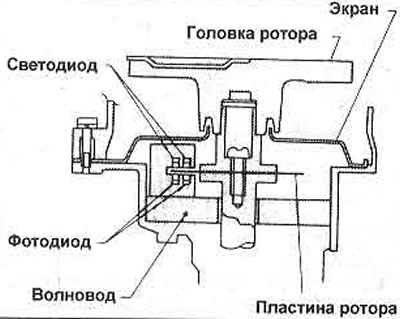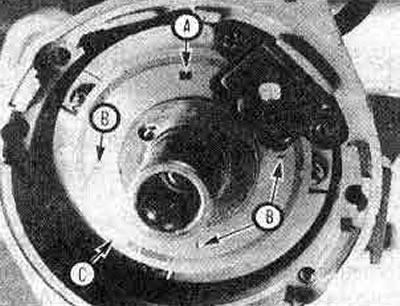Main components - ECCS control unit, ignition distributor (with crankshaft angle sensor), power transistor and ignition coil, knock sensor (blow) (Turbo only), battery and ignition socket.
The ECCS unit receives information from the distributor/crank angle sensor to determine engine speed and crankshaft position (piston); from an air flow meter to determine the amount of incoming air; from the temperature sensor to determine the engine temperature; from the throttle valve switch to determine the throttle position; And (on Turbo models) from the knock sensor (see below). All information is compared by the control unit and is used to determine the optimal ignition timing setting for any engine operating mode, with the information programmed in the unit.
The control unit sends a signal to the power transistor about the selected ignition timing setting. The transistor amplifies this signal and connects and disconnects the low voltage circuit of the ignition coil, thereby causing a high voltage in the secondary winding of the coil. It is supplied through the distributor cap and slider to the spark plugs in the usual way.

Pic. 4.13. Section of the distributor/crankshaft angle sensor
The crankshaft angle sensor assembly inside the distributor consists of a plate, an LED and a photodiode. The plate that is attached to the distributor shaft is located at the bottom of the distributor housing. It has 360 slits along the outer edge. These cuts correspond to the degree of rotation of the crankshaft. Near the outer row of cuts there is a row of four large cuts corresponding to each cylinder in the engine. They are separated by 180°. The cut for cylinder #1 is slightly larger than the cuts for the other cylinders (photo).

8.0. Cylinder No. 1180°signal cut 'A', 180°signal cuts 'B', 1°signal cut 'C'
The circuit that generates the signal is placed under the plate. The LED is located in the upper half, and the photodiode is located in the lower half of the small housing. When the engine is running, the LED emits a continuous beam of light onto the photodiode. The cuts pass the beam, producing pulses in the photodiode, which are converted into on-off pulses and sent to the ECCS unit, which uses the signal to determine the position of the crankshaft and engine speed.
A turbocharged engine, with higher manifold pressures and temperatures, requires additional protection in the form of a knock sensor.
This sensor detects detonation as pressure applied to the piezoelectric element. It is converted into a voltage signal, which is sent to the ECCS block. Whenever the control unit detects this signal, the ignition timing is reduced until the knock disappears, then the ignition timing returns to the normal setting.